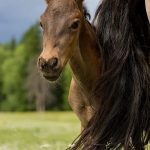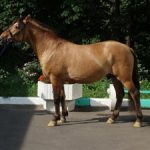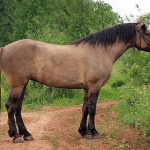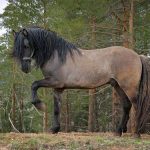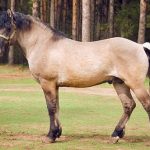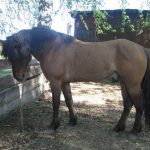Vyatka Horse
The Vyatka, also known by Viatka, is an endangered horse breed found in the Kirov Oblast (formerly Vyatka region), Perm Krai, and the Udmurt Republic in Russia.
Vyatka Horse Pictures
- Vyatka Horse Foal
- Vyatka Horse Images
- Vyatka Horse Mare
- Vyatka Horse Pictures
- Vyatka Horse Stallion
- Vyatka Horse
- Vyatskaya Horse
- Vyatskaya Loshad
Quick Information
| Other Names | Vyatskaya, Vyatskaya Loshad |
| Temperament/ Personality | Willing, gentle, friendly |
| Physical Characteristics | Clean-cut head, wide forehead, broad jaws; short, well-arched, fleshy neck; average-sized withers; broad and long back, slightly dipped withers, short and wide croup; short, solid legs with good hoofs; thick and long mane and tail |
| Colors | Bay-roan or chestnut-roan; bay, brown, chestnut, and black are also seen; zebra striped forelegs, wing-shaped pattern at the shoulders, black striped spine |
| Height (size) | At withers: 13.8 hands (140 cm) Oblique body length: 14.8 hands (150 cm) Cannon bone circumference: 18.9 cm Chest girth: 170 cm |
| Weight | About 880 lb (400 kg) |
| Blood Type | Warm-blooded |
| Common Uses | Transportation, riding, and draft horse |
| Health | No known health issues specific to this breed |
| Popular Traits | Extraordinary endurance, sufficient speed, draft ability, good fodder utilization |
| Feeding/Diet | Hay, grass; grain and other concentrates |
| Originated in | The Russian Federation |
| Ancestors | Kleppers, Estonian Horses |
Video: Riding the Vyatka Horses
History and Development
The Vyatkas, a part of the North Russian group of ponies, were influenced by the terrain and climate of their native land. However, their conformation was also affected by Estonian horses imported by the Novgorod colonists during the 1300s. Moreover, the Estonian horses imported for working in the mines of the Ural Mountains played a role in the development of the breed.
Aside from agility, resilience, and working ability, the Vyatka horses were valued as the best equine for pulling troikas. During peak popularity, the horses were exported to many countries including Poland.
In the early twentieth century, the mechanization of agriculture, industry, and transportation caused a sharp reduction in their numbers. Furthermore, the mating of purebred mares with trotters and heavy draft horses pushed the breed close to extinction. Subsequent efforts of re-establishing the breed proved successful as the population reached 2000 in 1980. However, it declined to 560 in 2003, and it was recognized as an endangered breed by the FAO in 2007.


